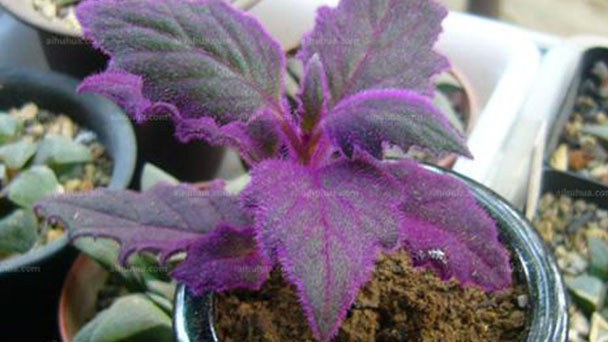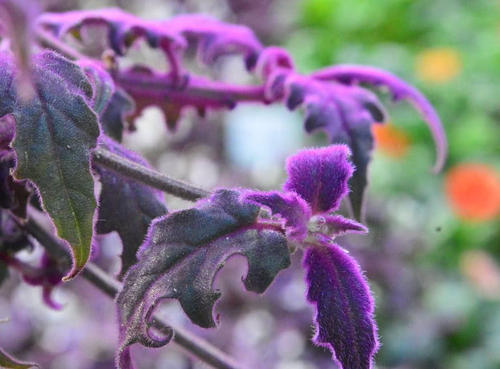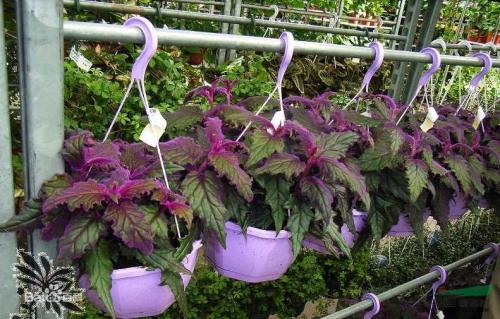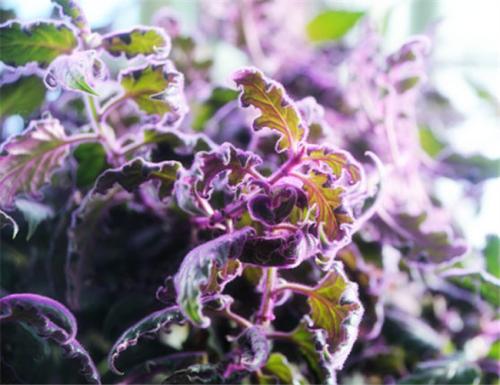Velvet plant (Gynura aurantiaca) profile
Written by Maggie
Mar 18 2021

Velvet plant (scientific name: Gynura aurantiana), also known as purple passion, etc., belongs to the chrysanthemums perennial herbs or subshrubs, stems thick and branched. Leaves are opposite, long ovates. Leaf margin is coarsely doubly serrate. Because the stem and leaves are densely draped like goose down and the purplish red fine hair named. Velvet plants are known for their leaves, which are covered with velvet-like hairs. They are usually used as potted plants or hanging pots to beautify and decorate bright study, living room, window sill and other places. The Velvet Plant's leaves were green instead of purple, which was caused by lack of light.
Velvet plant picture

Velvet plant info
| Botanical Name | Gynura aurantiaca |
| Common Names | Velvet plant, purple passion |
| Plant Type | Herbaceous perennial |
| Sun | Part shade |
| Hardiness Zones | 10–12 (USDA) |
| Flower color | Orange, yellow |
| Native Area | Asia |
| Mature size | 1–2 ft. tall, 2–4 ft. wide |
Morphological characteristics of velvet plant
Stem branches
Velvet plants are evergreen perennial herbs, branching and trailing. Stems are juicy, erect when young, pendulous or prostrate when grown. The stem and leaf are densely purplish red tomentose.
Leaf
Velvet plant leaves are opposite, ovate or broadly elliptic, 8 -- 15 cm long and 4 -- 5 cm wide; The leaf margin has the coarse compound serrate, the leaf end is sharp, the vein palmately obvious. The young leaves are purplish red, dark green when they grow up, and the whole plant is densely covered with purplish fuzz. velvet plants are very distinctive in foliage plants.
Flowers
The flowers of the velvet plant are yellow or orange, like dandelion flowers, in their axillary heads. They sometimes give off an unpleasant smell, so the buds are often removed.
Ecological habits of velvet plant
Velvet plant likes warm, moist, light semi-humid and ventilated environments, avoid direct sunlight, and cold resistance is not strong. The suitable temperature for growth is 18-25℃, and the overwintering temperature is about 8℃.
How to grow and care for velvet plant
The basin
When the seedlings of Velvet plant are loaded into the pot, first put 2~2 cm thick coarse grain matrix or ceramsite as a filter layer on the bottom of the pot, sprinkle a layer of fully decayed organic fertilizer as a base fertilizer, about 1~2 cm thick, and then cover with a layer of substrate, about 1~2 cm thick, and then put the plant, to separate the fertilizer from the root system, to avoid root burning.
Base for pots
You can choose one of the following: garden soil: slag = 3:1; Or garden soil: medium river sand: sawdust = 4:1:2; Or paddy soil, pond mud, leaf rot soil in one of the. Or peat + perlite + ceramsite =2 copies +2 copies +1 copies; Garden soil with slag =3 parts +1 part; Peat + slag + ceramsite =2 parts +2 parts +1 parts;Sawdust + vermiculite + medium river sand =2 parts +2 parts +1 part. Pour a permeable water after the basin, and put in the shade environment maintenance.
Moisture care
Velvet plant likes a humid climate environment, the relative temperature of air in the growth environment is required to be 60~75%.
Temperature care
The optimum growth temperature for Velvet plant is 18℃~30℃, avoid cold frost, overwintering temperature needs to be kept above 10℃, in winter the temperature drops below 4℃ into hibernation state, if the ambient temperature is close to 0℃, will die due to frostbite.
Summer care
1. Strengthen the air convection, so that the body temperature can be emitted;
2. Put in the half shade, or give it shade 50%;
3. Spray Velvet plant appropriately 2~3 times a day.
4. Avoid stuffy wet, avoid high temperature, otherwise the leaf will also wither.
Winter care
1. Move Velvet plant to an indoor place with bright light for maintenance. If the light is insufficient, the leaves will turn green.
2. In the outdoors, Velvet plant can be wrapped in film for winter, but every two days it is necessary to uncover the film and let it breathe when the temperature is higher at noon.
3. In production, it is best to heat up, otherwise it is not easy to grow, less than 10℃, and the leaves may appear red frozen spots.

Watering
During the growing season, water the Velvet Plant according to the "better wet than dry" principle. Once the soil is dry, the leaves will wilt and droop. At this time, water or spray water immediately to restore their vitality. Do not spray water on the leaf surface to avoid rotten leaves.
Fertilization
In the growing season, fertilizer can be applied once a week, less nitrogen fertilizer, so as not to cause barren growth and leaf fading.More phosphorus and potassium fertilizer, fertilizer should pay attention not to touch the leaves.
Light
Velvet plant is fond of light, and requires sufficient light, but shade should be appropriate in summer to avoid strong light, otherwise it will make the leaves brown and black, showing dry and dehydrated state, and the plant will be damaged. On the contrary, the lack of light, its leaf thin, leaf color fade, affect the ornamental.
Humidity
When the relative humidity is 50 to 60 per cent, the Velvet Plant will be more vivid and vibrant. Therefore, every day should be timed to the location of appropriate sprinkling water, pay attention to do not make the leaf water. This work is especially important during the summer heat.
Repotting
The Purple Velvet plant is typically only kept inside for two to three years, so you likely won’t ever have the need to repot it. As the plant ages the purple hairs covering the leaves fade and become less vibrant, eventually turning a dark, dull, and somewhat unattractive shade. It is at this point that the owner will usually dispose of the plant or find a home for it outside.
During its short lifespan, the plant may become root-bound and look like it needs to be re-potted on, but the Purple Velvet plant actually does very well in space limiting conditions, and it usually isn’t necessary to repot it. If you do decide to repot the plant, do so with great care to not disturb the roots, as they are very fragile and may not respond well to change.
Disease control of velvet plant
Velvet plant has aphids that damage leaves and buds, can be washed with soapy water or scraped off, in serious cases can spray 80% of dichlorvos emulsion 1200 ~ 1500 times liquid control.
Velvet plant distribution area
Velvet plants are found in tropical parts of Asia such as Indonesia.
Velvet plant uses
Ornamental value
As a kind of leaf viewing plant, the unique appearance of the Velvet Plant made people favor it.Velvet plants grew in neat rows of teeth. The Velvet Plant is a unique example of a flower that has a large number of oval leaves, but by then fewer are covered with fine hairs. The Velvet Plant, which offers a relaxed and soft beauty, has become increasingly popular as a flower.
Potted role
Velvet plants are often placed at home as a kind of domestic potted plant, mainly because the vet plant has a soft appearance and can add warmth to the home. And the color of the Velvet Plant seems to brighten people's eyes, which can enrich people's visual effect, making it a good choice for home decoration.
Greening effect
Velvet plants can trap harmful gases from the air and act as a green, so they are often put in places where they can be used to trap harmful gases. So add a Velvet Plant to a few windowsills or coffee tables for a pleasing look and a cozy home.

Latest Updated
- Benefits of Bugleweed - 7 Science-backed Health Benefits
- Bugleweed Dangers & Side Effects - Is It Poisonous?
- How to Plant Evergreen Trees - What You Should Know
- When to Plant Evergreens - Grow Guide for Evergreen Trees
- 12 Wonderful Evergreen Shrubs for Your Garden
- 12 Popular Evergreen Plants with Pictures for Beginners
- When And How To Prune A Lilac Bush Like a Pro
- How to Grow & Care for Lilac Vine (Hardenbergia Violacea)
- Japanese Lilac Tree (Syringa Reticulata) Care & Propagation Guide
- Shumard Oak Pros and Cons - What to Know
Popular Articles
- Winter maintenance of Antirrhinum Majus
- How to Grow Terminalia Mantaly Tree
- How to Grow and Care for Crossostephium Chinense
- How to grow Antirrhinum Majus in spring
- Peristeria Elata (Dove Orchid) Profile: Info & Care Guide
- Underwatered Snake Plant (Sansevieria Trifasciata) - Signs And How To Fix
- How to Care for Brazilian Jasmine Plant (Mandevilla Sanderi)
- How to Grow & Care for Graptopetalum Purple Delight in Summer
- Rosa Chinensis (China Rose): Plant Growing & Care Tips
- How to Care for Baby Sun Rose (Aptenia Cordifolia)